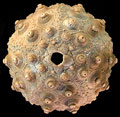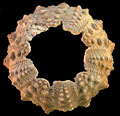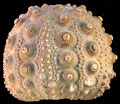|
Diagnostic Features
|
-
Test tall, hemispherical, flattened beneath.
-
Apical disc small, less than one-quarter test diameter; plating dicyclic or hemicyclic with oculars I and V insert. Genital plates large, hexagonal, G2 generally the largest. Periproct with smooth outer edges.
-
Ambulacra narrow, often slightly sinuous above. Plating trigeminate; compounded in acrosaleniid style above ambitus, with all three elements extending to perradius. Pore-pairs uniserial above and at ambitus, expanded adorally to form phyllodes. Primary tubercles large on oral surface, much smaller but still discernible (unitiing two of the three elements in each triad) above.
-
Interambulacral plates a little wider than tall, dominated by a large primary tubercle. Narrow band of small secondaries and granules interradially and adradially.
-
Primary tubercles perforate and crenulate. Those of the ambulacra very much smaller than those of the interambulacra.
-
Peristome large, more or less flush, with deep open buccal notches giving the peristome edge a crenulate appearance.
-
No sphaeridial pits and no basicoronal interambulacral plate retained in adult.
-
Lantern stirodont, with keeled teeth.
-
Primary spines much longer than test; simple, cylindrical shaft with smooth cortex, tapering distally.
|
|
Distribution
|
Lower Jurassic (Toarcian) to Lower Cretaceous (Valanginian), Europe, North Africa.
|
| Name gender |
feminine |
| Type |
Cidarites crenularis Lamarck, 1816, p. 59, by original designation.
Agassiz (1838, p. 3) established this genus to accommodate a number of species most of which were known only from test morphology, including Lamarck's Cidarites crenularis, which he designated as type species. Unfortunately, tests with the morphology of crenularis were subsequently found to come from two discrete species, one with long, slender spines, the other with thick clavate spines. Cidarites crenularis Lamarck, 1816 is therefore a nomen dubium, as associated spines are unknown.
Agassiz (1839, pl. 18, fig. 23) illustrated a specimen he called Hemicidaris crenularis (Lamarck) which had clavate spines, and indeed included the possession of clavate spines in his definition of the genus Hemicidaris in 1838. This specimen was later described by Merian, in Desor, 1855) as Hemicidaris quenstedti and later made the type species of Sphaerotiaris Lambert & Thiery, 1914.
The type-material of Lamarck came from the Swiss Alps where both the slender-spined form and that with clavate spines occur (Hess, 1975). To clarify the identy of the type-species Lamarck's material needs to be re-examined to establish to which form it belongs. If the type material turns out to be lost a neotype will need to be established. If it turns to out not to be diagnostic, an appeal to the ICZN under article 75.5. will be necessary which request the Commission to set aside under its plenary power the existing name-bearing type and designate a neotype.
|
| Species Included |
-
H. intermedia (Fleming, 1828); Oxfordian, Europe.
-
H. bigoti Cotteau, 1893; Toarcian, France
-
H. luciensis d'Orbigny, 1850; Bathonian, Europe [includes H. langrunensis Cotteau, 1857 and H. grimaultensis Cotteau, 1881].
-
H. microtuberculata Cotteau, 1881; Bathonian, France.
-
H. serialis (Quenstedt, 1852); Oxfordian, Germany.
-
H. mitra Agassiz, 1840; Kimmeridgian, France.
-
H. hoffmanni (Roemer, 1836); Kimmeridgian, Germany.
-
H. purbeckensis Forbes, 1850; Tithonian-Berriasian; Europe.
-
H. glasvillensis Cotteau, 1881; Portlandian, France.
-
H. morinica (Sauvage & Rigaux, 1872); Portlandian, Europe.
-
H. hemisphaericus (Roemer, 1836); Portlandian, Europe.
-
H. mantochenensis Etallon, 1864; Portandian, France.
-
H. quenstedti Merian, in Desor, 1856; Oxfordian, France.
-
Plus many more nominal species not checked.
|
| Classification and/or Status |
Carinacea, Hemicidaridae, Hemicidarinae.
|
| Remarks |
Agassiz, L. 1838. Monographies d'Échinodermes vivants et fossiles. Première monographie: Des Salénies. Petitpierre, Neuchâtel, 32 pp., 5 pls.
Beurlen, K. 1937. Revision der Seeigel aus dem norddeutschen Jura II. Die regularen Seeigel. Abhandlungen der Preussischen Geologischen Landesanstalt 174, 1-149.
Smith, A. B. & Wright, C. W. 1993. British Cretaceous Echinoids. Part 3, Stirodonta 2 (Hemicidaroida, Arbacioida and Phymosomatoida, part 1). Monographs of the Palaeontographical Society 147, 199-267, pls 73-92.
|




